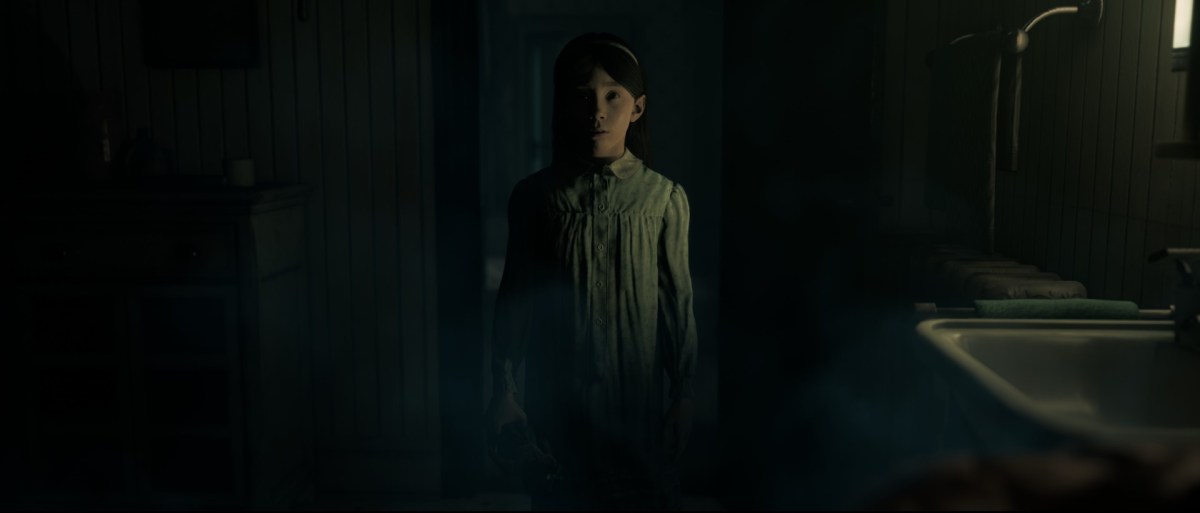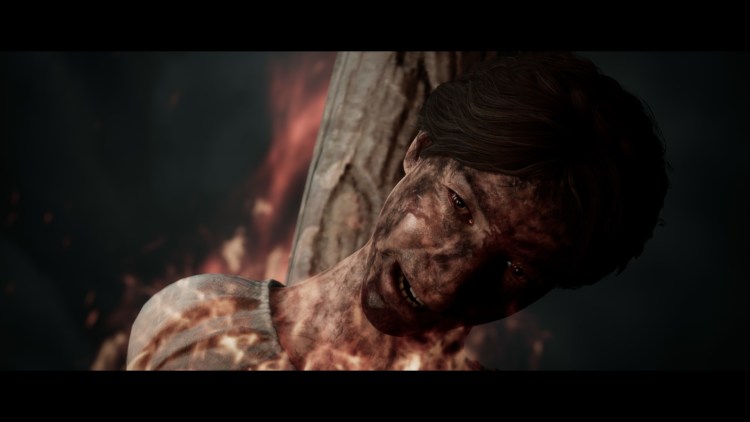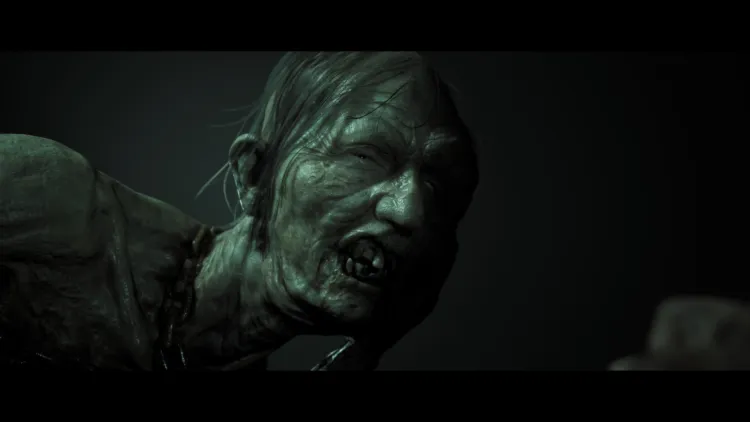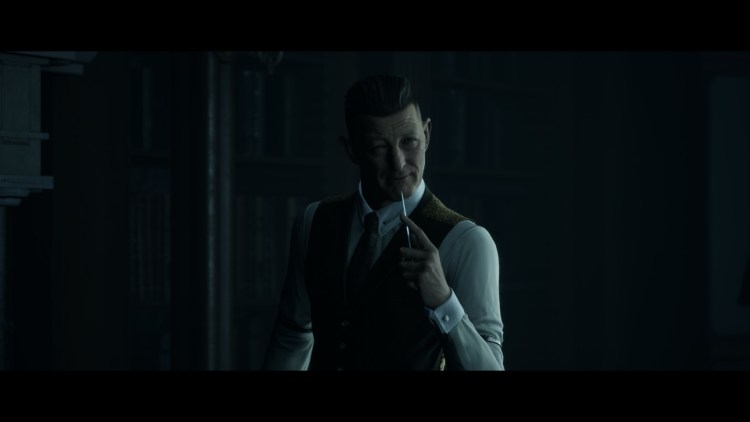The Dark Pictures Anthology: Little Hope might take place in modern-day New England, but it also tells the tale of a town steeped in a dark past. That’s because the game is inspired by the events of the Andover Witch Trials which happened late in the 17th century. Here’s our story analysis.
Note: For more information about The Dark Pictures Anthology: Little Hope, check out our full Theatrical Cut walkthrough, finale and endings guide, as well as our guides and features hub. Please be reminded that this article contains major spoilers.
The Dark Pictures Anthology: Little Hope – Story analysis
The Dark Pictures Anthology: Little Hope shares a similar concept with the previous game in the series, Man of Medan. The interactive game might take place in the present day, but it’s presaged by a horrifying myth or legend from the past.
In Man of Medan, this was the tale of the SS Ourang Medan. The World War II-era freighter was discovered to have countless dead corpses with only shocked and pained expressions on their lifeless faces. That game’s story had divers, thrillseekers, and pirates searching for a treasure called “Manchurian Gold.”
In Little Hope, most of the game takes place in modern times. A bus carrying four students, Andrew, Taylor, Daniel, and Angela, and their professor, John, crashes. The five wake up, realizing that the bus driver is gone. You have to guide them as they make their way through a dreary, fog-covered town. But, there’s more to this story than meets the eye.
The Clarke residence
Little Hope‘s prologue shows you the dysfunctional Clarke family. We don’t really get into the details of their problems, but it’s safe to say that the marriage of James and Anne was falling apart. The children are, likewise, introduced. Tanya is out and about dating, and Dennis seems to be more interested in vinyl records.
Meanwhile, the youngest, Megan, tends to be considered “trouble” — she annoys her siblings and she worries her parents due to her failing grades. Lastly, Anthony, the main character played by Will Poulter, seems to be the glue that holds their relationships together.
Things come to a head one night when Anthony decides to boil some water. Going outside to the yard, he sees the kitchen burning after Megan accidentally places her toy next to the fire. The flames spread and eventually engulf the entire home.
Anthony watches in horror as his family members die one by one. The ceiling collapses on James, crushing him to death. Anne is trapped in the bathroom and asphyxiates. Dennis attempts to escape via the rooftop, but he slips and gets impaled on the fence. As for Tanya, Anthony can choose how she could save herself, but either method still leads to her doom (either by hanging or due to a backdraft’s explosion). Lastly, Megan is seen consumed by fires.
Anthony rushes inside; his fate unknown. You then see Tanya’s funeral where her boyfriend mourns her passing.
The town of Little Hope
We jump back to the present day where the fog-covered town of Little Hope slowly fills each character with visions of the past. Given that the town is somewhere in New England, it’s steeped in the lore surrounding the witch trials that happened centuries ago. There are hints of pagan rituals, poppets (straw dolls), and effigies. We even see a Museum of Witchcraft and a hiking trail through execution sites.
Indeed, characters start seeing oddly-dressed people with strange accents. Then, they’re provided a glimpse of accusations that brought people to trial followed by their subsequent execution. These occur while the fog continues to disorient them, pushing them ever closer to the town’s center. It’s reminiscent of classic horror titles like the Silent Hill games.
The Andover Witch Trials
As mentioned earlier, The Dark Pictures Anthology: Little Hope is inspired by real-life events from history — The Andover Witch Trials which occurred in 1692. These incidents caused by religious fervor, malicious accusations, and mass hysteria resulted in the deaths, imprisonment, and suffering of many inhabitants in New England.
While the Salem Witch Trials became the most well-known among these, the vast majority of accusations of witchcraft and devil worship actually happened in other towns such as Andover. In 1692, over 50 citizens of Andover, a town with a population of 600 people, were accused and brought to trial.
We know of a few major cases from the Andover Witch Trials:
- In May 1692, Martha Carrier was accused of witchcraft. When she and her family had recently moved to Andover, they had smallpox (back then, diseases were thought of as brought upon by the wrath of God). Martha was also known as someone who was very outspoken, earning the ire of the conservative Puritan townsfolk. Martha was hanged in August 1692, but accusations of witchcraft continued to hound her family.
- Next, William Barker was accused by girls in Andover. He ended up confessing and was made to serve a prison sentence. This became the catalyst for even more paranoia that followed. As additional people were accused and brought to trial, confession and the naming of their neighbors (probably someone who wasn’t even guilty) became the means of salvation. The refusal to confess led to harsher punishments and cruel execution methods.
- The third and final wave of witchcraft accusations was started by Joseph Ballard. He brought girls from Salem — those who were thought of as afflicted or bewitched — to Andover so they can point out townsfolk who might be guilty.
Little Hope‘s depiction
In The Dark Pictures Anthology: Little Hope, the story of the Andover Witch Trials is depicted in numerous scenes, locations, and flashes of visions. It starts when they see a girl named Mary who seems to be under the influence of the devil. However, she starts pointing fingers at various townsfolk.
First, a woman named Amy is chained and drowned in the river. Next, a younger woman named Tabitha is either burned at the stake or hanged. Then, her brother David is falsely accused. He falls to his death from a church’s bell tower and is impaled on the fence below. Lastly, Amy’s husband Joseph is seen crushed by large rocks, another brutal method of execution.
As you may have guessed by now, the names of the townsfolk, their appearance, and their method of execution mirror those of the Clarke family’s:
- James (1972) and Joseph (1692) were both crushed by heavy objects.
- Anne (1972) and Amy (1692) were suffocated and asphyxiated. The former while in the bathroom, and the other via drowning in the river.
- Dennis (1972) and David (1692) both fell from a great height only to get impaled.
- As for Tanya (1972), her death in the Clarke family home will coincide with how Tabitha (1692) is executed in Little Hope.
Meanwhile, Andrew has a double named Abraham who ends up caring for Mary with her family gone. Mary herself is a stand-in for Megan, the youngest child in the Clarke family.
Note: In Little Hope, the attempts of present-day characters to interact with or help those from 1692 actually exacerbate the situation, making the priest, Carver, think that the devil is in their midst.
The demons
In the present-day arc of Little Hope, your characters are chased by demons. These are embodiments of the cursed inhabitants from the 1692, essentially their dead doppelgangers attempting to murder them.
The design of these creatures is reminiscent of their execution methods: a drowned woman in chains, a victim covered in spikes, a broken man all twisted and bent, and either a burned lady attached to a stake or a hanged lady who uses her tongue to grasp at victims.
While the demons scare off all other characters with you in a particular scene, they’ll only go for a specific person — their double.
This is why Angela can only be killed by the drowned woman, but the demon with spikes will never be after her. What is their purpose? Well, I’ll mention it in a while.
The Curator’s role
While progressing through Little Hope‘s story, you’ll learn a bit from the Curator, the omnipresent watcher in The Dark Pictures Anthology. In a previous Man of Medan article, I mentioned that the character (played by Pip Torrens) is the personification of death. Indeed, you’ll even see him from time to time in case someone died or is about to die.
Likewise, he provides you with hints regarding the plot. In his first hint, he recites a line from William Shakespeare’s The Winter’s Tale:
Do as the heavens have done, forget your evil;With them forgive yourself.
Every saint has a past, and every sinner has a future.
Little Hope‘s character dilemmas
Both passages signify remorse, redemption, and forgiveness. At first, you might think that they’re about Megan/Mary. After all, she accidentally started the fire and was the one who accused the townspeople. However, these passages also pertain to Andrew and the other characters. The journey in Little Hope is more about their redemption.
The demons of past executions in the town represent the metaphorical demons of the characters, their flaws and fallibilities made manifest. What this simply means is that you’re not just attempting to survive QTEs and fight scenes, but you’re also expected to make the right decisions that would present that character’s “bearing” in a more positive light.
Here are some examples:
- John, the “Authority Figure,” needs to take on a leadership role and avoid being indecisive.
- Angela needs “A Deeper Understanding.” She can’t be too mean-spirited or callous.
- Daniel, the “Homegrown Hero,” has to show his bravery and selflessness.
- Lastly, “Team Taylor” means that she can’t be too headstrong all the time. She has to get along with others.
This is why, if a character dies, their worst traits flash in their demon’s eyes. It’s a way of showing that they’re judged upon death.
Exploring the town of Little Hope is their redemption, a means of changing for the better. Meanwhile, the demons that hound them represent their failure to do so.
Andrew and Vince
To tie up Little Hope‘s narrative, the ending scenes show you what happened to Vince, the lonely drunk you met earlier in a bar. It’s revealed that Vince was actually Tanya Clarke’s boyfriend, the same man who was mourning at her funeral. His journey in town, now a shell of its former self due to the closure of businesses, also mirrors his regrets as he reminisces about his lost love.
Likewise, it’s revealed that the demons don’t exist, at least in the physical sense. In fact, the other four characters don’t exist at all. Andrew was all alone as he was exploring Little Hope. Andrew is Anthony Clarke, the same teen who survived the house fire that killed his entire family in 1972. This was even alluded to in one scene with the Curator. He shows you several cards representing the five playable characters in the game. Then, he turns them over to show the same card five times. This implies that all five people were one and the same: Anthony, or, rather, how Anthony would imagine each character acting out.

Anthony/Andrew was also the bus driver at the start of the game, crashing the vehicle after seeing an apparition of Megan. He’s concussed, wandering, and trying to make sense of it all.
The death of Anthony’s family filled him with guilt, remorse, and psychological trauma. That’s why he doesn’t have a demon chasing him the entire time. The tragic events of the past, and his failure to save his family (personified by the other playable characters surrounding him in Little Hope), were the very demons that haunted him throughout his life. Likewise, he sees representations of others, such as the neighbor who “judged” him for the house fire (who appears as a judge in 1692) and faceless, mannequin-like townsfolk (symbolizing faceless accusers who thought he murdered his family).
Furthermore, if you look closer, Andrew is shown rescuing every other playable character from certain doom. He could save Angela in “The Crossing,” then Daniel in “Low Point” and “Ruined.” At the end of “Surrounded,” he’s the one who grabs Taylor’s hand when she gets lost in the fog. Then, at the end of “Heavy Burden,” he bashes the demon that pounced on John.
Your entire playthrough of The Dark Pictures Anthology: Little Hope is Andrew’s/Anthony’s attempt to come to terms with his guilt. He seeks forgiveness and the aptly named town is essentially his way of finding a “little hope,” too. Perhaps the survival of his classmates and professor — or family members, rather — was a means of atoning for his mistakes and regrets.
What about Mary/Megan and the devil?
Throughout Little Hope‘s story, you can decide to blame Mary and think of her as under the influence of the devil. Alternatively, you could consider her innocent. Then, towards the end, you have the option to save her or condemn her for witchcraft.
As for the devil, I believe the good ending requires you to consider that Mary is innocent and that it’s the priest, Father Carver, who’s evil. Throughout the game, Carver decries the alleged occult practices of townsfolk, leading to subsequent executions. It falls in line with what happened historically during the Salem and Andover Witch Trials — towns in the grips of a sinister witch hunt and mass hysteria all in the name of religion Likewise, you see Carver’s name crossed out in the chapel’s list in “Surrounded.” Meanwhile, there’s also another “Carver,” a politician with a campaign poster in “Ruined.” The poster itself is vandalized with devil horns implying that he’s the source of Little Hope‘s woes (i.e., factory closure and the area becoming a ghost town).
As for Megan, her arc is related to Anthony’s dilemma. It also makes sense considering that Anthony saw that Megan’s toy caused the fire to spread. The constant blame put on Megan by the Clarke family, along with the tragic fire, makes Megan the target of scrutiny. Additionally, if you check out some of the secrets from the 1972 arc, you’ll even notice that Megan seems to be under the disciplinary care of a Reverend Carson — not Carver, but the similarities are on-the-nose. It seems Reverend Carson, in a secret found by Daniel in “Another Way,” was alleged to have been delving in the occult and witchcraft as well.
Then again, in the prologue, Megan is shown holding a key (implying that she locked her mother in the bathroom). Then, a shadowy hand of a demon is seen right behind her. Was Megan truly corrupted by the devil the entire time, or was Reverend Carson (a stand-in for Carver in 1972) somehow involved? The subtext itself wasn’t fully addressed, but were Megan and Mary being abused by the priest in their respective timelines?
Can you change the past?
As for why the Andover Witch Trials became the backdrop of Little Hope‘s present-day narrative arc, I believe it’s due to Anthony’s hobby. In a couple of scenes, it’s shown that Anthony (as the bus driver) has a book about occult rituals. Then, in the 1972 prologue, teenage Anthony mentions that reading horror books and others about black magic became his “escape” from his troubles. Worrying about revisiting a town that filled him with dread, concussed after the accident, and still living with regrets, Anthony’s means of escape was his imagination that the witch trials from the distant past were still occurring.
Those who’ve played Man of Medan might feel that Little Hope had yet another “it’s all in his head” plot twist. Condensed in the simplest form, that would be true. However, I do think the story is a lot deeper and richer given that it deals with Anthony’s aforementioned trauma and remorse as opposed to just something that’s supposed to spook you. (I’m looking at you, Manchurian Gold).
Although the other playable characters in Little Hope don’t exist in the present day, they’re still real in Anthony’s mind. That’s why you kept seeing their deaths in 1692, 1972, or the current timeline — Anthony is still going through that trauma of not being able to change the past. It’s only at the very end of the game when Anthony realizes that they’re truly gone. If they survived the night, it means that you preserved their best traits in Anthony’s mind, allowing him to be at peace with those memories as he tries to move on. If none of them did, then Anthony takes his life as, even in this state, he was still unable to save his loved ones.
Lastly, I’ll leave you with something to ponder on. If you check Little Hope‘s finale, you’ll notice that the same bathroom key held by Megan in the prologue is hidden in the grandfather clock. I did a few replays to see if the prologue’s events can be changed after finishing the game. The Curator did say that the events may not have come to pass (yet). I kept wondering if there was a way for Anthony to find that key, save his family, and discover an entirely different ending. But, alas, I don’t even think that’s possible.
The Dark Pictures Anthology: Little Hope is available via Steam. For more information, check out our guides and features hub.


























